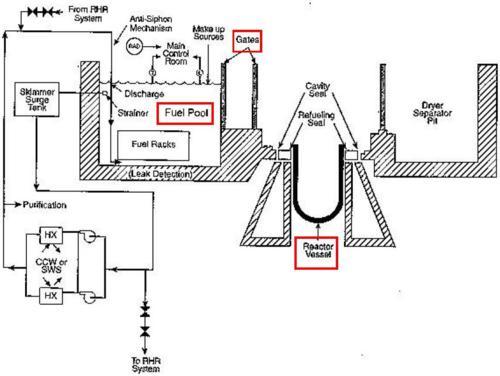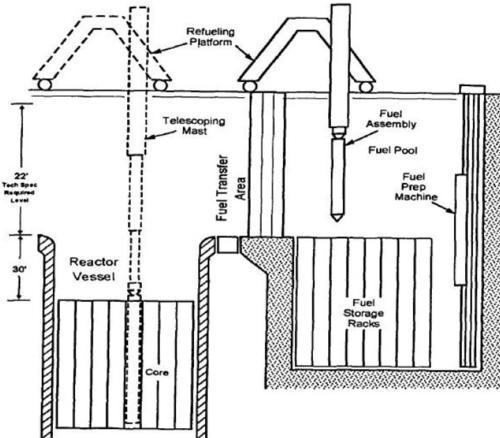A current focus of concern in Japan now is the pools at the reactors where spent fuel is stored. Some of this spent fuel is still very radioactive since it was only removed from the reactors a few months ago, and it must be covered by water and cooled to keep from overheating. If the spent fuel rods get too hot, they can suffer damage and release significant amounts of radioactive gases into the atmosphere, and could eventually catch fire.
Since several of the reactor buildings that surround these pools have been damaged by explosions, the radioactivity released from the pools in those buildings would get directly into the atmosphere. Similar fuel damage within the reactor cores would be surrounded by the reactor’s primary containment so that a much smaller fraction would get out, unless there was a significant breech of the containment.
Water needs to be added to the spent fuel pools at Fukushima since heating by the spent fuel causes the water to evaporate and boil off.
In addition, reports from Japan say that the spent fuel pool at reactor Unit 4 is leaking, which further increases the need for additional water.
A possible source of the leak in the Unit 4 pool may be the seals around the doors (or “gates”) on one side of the spent fuel pool. These gates are shown in the diagram below. They are located between the pool and the area above the reactor vessel. They are concrete with metal liners, and are roughly 20’x 3’.
When fuel is moved between the pool and vessel, this whole region is filled with water, the gates are opened, and the fuel can be moved to or from the reactor core while remaining under water. The water not only keeps the fuel rods cool but acts as a radiation shield.

Boiling Water Reactor (BWR) Spent Fuel Cooling System
When the gates are closed, they are made watertight by an inflatable seal, similar to a bicycle innertube, that runs around the sides and bottom of the gates. Electric air pumps are used to inflate these seals and keep them inflated as air leaks out of them over time.
These pumps are powered by electricity from the power grid, and not by backup diesel power or batteries. So once the power grid in Japan was knocked out, these seals could not be inflated if they lost air over time. If these seals lost air they could lead to significant water loss from the pool, even if there were no direct physical damage to the pool from the earthquake or tsunami. This may be what happened at pool 4, and could affect the other pools as well.
We saw an example of this in the US at the Hatch nuclear plant in Georgia in December 1986. This reactor is very similar to the reactors at Fukushima. In the Hatch case, the line supplying air to the inflatable seal was accidentally closed, the seal lost pressure and created a leak, and by the time the problem was identified several hours later some 141,000 gallons of water leaked from the pool—about half the water in the pool Fortunately, the source of the problem was discovered and fixed before the water level uncovered the fuel.
An NRC document on the leak gave this description of the event:
A valve in the single air supply line to the seals was mistakenly closed. Although water level dropped about 5 feet and low-level alarms in the spent fuel pool worked, the leak was not specifically identified for several hours because a leak detection device was valved out and none of the seals were instrumented to alarm on loss of air pressure.
The NRC document goes on to note that if the water level had gotten low enough to expose the fuel the high radiation level around the pool would have made it difficult for workers to fix the problem.
The closed air line in the Hatch case had the same result that lack of electric power the air pump inflating the seals in Japan could have.
_________________________________________________________________

The spent fuel pool appears on the right side of this diagram. The reactor vessel and its reactor core appear on the left side. The refueling platform is used to move fuel assemblies one at a time between the reactor core and the spent fuel pool through an opening in the spent fuel pool wall created by removal of a gate.
_________________________________________________________________

Overhead view of an irradiated spent fuel bundle being transferred from the reactor core (lower right) to the spent fuel pool (upper left) through what is called the “cattle chute” at the Browns Ferry Nuclear Plant in Alabama. The spent fuel pool gate has been removed to connect the spent fuel pool water with the water in the reactor well area above the open reactor pressure vessel.
_______________________________________________________________

Looking down at the fuel transfer canal at the Grand Gulf Nuclear Station in Mississippi. Grand Gulf is a BWR with a Mark III containment. It features a fuel transfer canal that does not exist in the BWR Mark I and Mark II containment designs. However, all three Containment designs feature gates that are removable from the spent fuel pool walls to allow underwater transfer of spent fuel assemblies. In this picture, the fuel transfer canal is in the center, the spent fuel pool is to the left, and the cask loading area is to the upper right and is used when fuel is transferred from spent fuel pool to casks.
_______________________________________________________________

Looking down into the spent fuel pool at the Grand Gulf Nuclear Station in Mississippi before the plant commenced operation. The spent fuel pool is drained of water. The fuel storage racks can be seen in the lower region of the spent fuel pool. The beams used to hold the racks in place against forces from an earthquake can been seen between the racks and the pool walls. In the lower right portion of the picture, the opening in the fuel pool wall created by the removal of the spent fuel gate can be seen.
________________________________________________________________

A cross-section fuel of a typical BWR spent fuel pool. The fuel pool gate appears on the left side of the pool. The bottom of the opening created when the gate is removed (or its seals leaking) is about 5 feet above the top of spent fuel in the storage racks at the bottom of the spent fuel pool.
